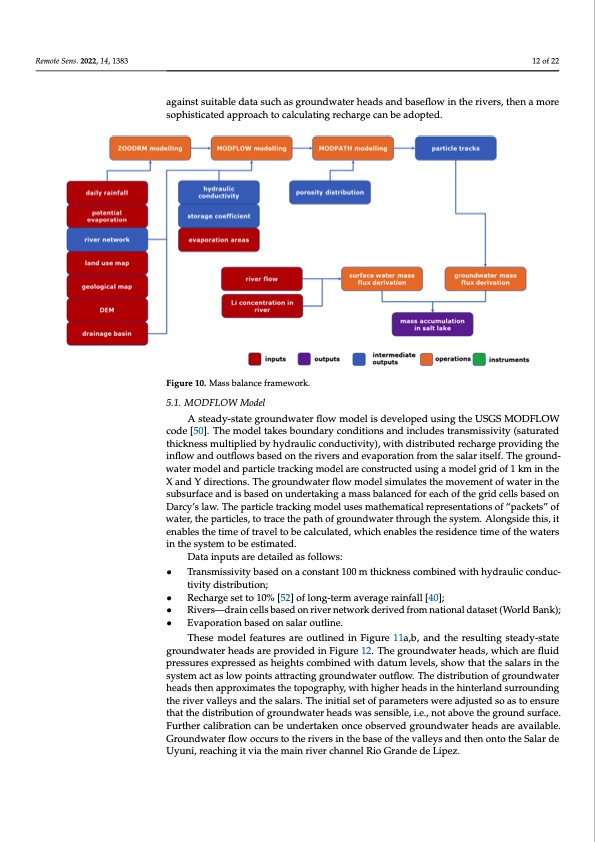
PDF Publication Title:
Text from PDF Page: 012
Remote Sens. 2022, 14, 1383 12 of 22 Remote Sens. 2022, 14, x FOR PEER REVIEW 12 of 21 against suitable data such as groundwater heads and baseflow in the rivers, then a more sophisticated approach to calculating recharge can be adopted. FFiiggurree1100. .Maasssbaallaancceeffrraameewoorrkk. . 5.1. MODFLOW Model Fluxes from groundwater and surface water masses are computed with the output of the mAosdtelaldinyg-satnadteggrroouunndddwaatate,reflsopwectmivoedlye.lTishdeyevaerelorpeeqduiuresdintgotchoemUpSuGteStMheOfiDnaFlLmOaWss caocdceum[5u0]la.tTiohneimnothdelsataltkleaskbe.oTuhnidsafryamcoenwdoitrikonhsasabnedeinecxlupdloeistetdrafnosrmthisesicvuirtrye(nstateusrtactaesde thickness multiplied by hydraulic conductivity), with distributed recharge providing the as described in the following. It is to be noted that the ZOODRM model has not been inflow and outflows based on the rivers and evaporation from the salar itself. The ground- applied in this case due to the availability of gridded rainfall for Bolivia providing a suit- water model and particle tracking model are constructed using a model grid of 1 km in the able first guestimate of recharge. It is thought that this method of estimating recharge is X and Y directions. The groundwater flow model simulates the movement of water in the commensurate with the complexity of the model and confidence of the other data sources. subsurface and is based on undertaking a mass balanced for each of the grid cells based on Once the groundwater model has been developed further and ground-truthed against Darcy’s law. The particle tracking model uses mathematical representations of “packets” of suitable data such as groundwater heads and baseflow in the rivers, then a more sophis- water, the particles, to trace the path of groundwater through the system. Alongside this, it ticated approach to calculating recharge can be adopted. enables the time of travel to be calculated, which enables the residence time of the waters in the system to be estimated. 5.1. MODFLOW Model Data inputs are detailed as follows: A steady-state groundwater flow model is developed using the USGS MODFLOW • Transmissivity based on a constant 100 m thickness combined with hydraulic conduc- code [50]. The model takes boundary conditions and includes transmissivity (saturated • Recharge set to 10% [52] of long-term average rainfall [40]; inflow and outflows based on the rivers and evaporation from the salar itself. The ground- • Rivers—drain cells based on river network derived from national dataset (World Bank); water model and particle tracking model are constructed using a model grid of 1 km in • Evaporation based on salar outline. the X and Y directions. The groundwater flow model simulates the movement of water in These model features are outlined in Figure 11a,b, and the resulting steady-state the subsurface and is based on undertaking a mass balanced for each of the grid cells groundwater heads are provided in Figure 12. The groundwater heads, which are fluid based on Darcy’s law. The particle tracking model uses mathematical representations of tivity distribution; thickness multiplied by hydraulic conductivity), with distributed recharge providing the pressures expressed as heights combined with datum levels, show that the salars in the “packets” of water, the particles, to trace the path of groundwater through the system. system act as low points attracting groundwater outflow. The distribution of groundwater Alongside this, it enables the time of travel to be calculated, which enables the residence heads then approximates the topography, with higher heads in the hinterland surrounding time of the waters in the system to be estimated. the river valleys and the salars. The initial set of parameters were adjusted so as to ensure Data inputs are detailed as follows: that the distribution of groundwater heads was sensible, i.e., not above the ground surface. · Transmissivity based on a constant 100 m thickness combined with hydraulic con- Further calibration can be undertaken once observed groundwater heads are available. ductivity distribution; Groundwater flow occurs to the rivers in the base of the valleys and then onto the Salar de · Recharge set to 10% [52] of long-term average rainfall [40]; Uyuni, reaching it via the main river channel Rio Grande de Lipez. · Rivers—drain cells based on river network derived from national dataset (World Bank); · Evaporation based on salar outline. These model features are outlined in Figure 11a,b, and the resulting steady-state groundwater heads are provided in Figure 12. The groundwater heads, which are fluid pressures expressed as heights combined with datum levels, show that the salars in thePDF Image | Lithium Brine Deposit Formation

PDF Search Title:
Lithium Brine Deposit FormationOriginal File Name Searched:
remotesensing-14-01383-v2.pdfDIY PDF Search: Google It | Yahoo | Bing
Product and Development Focus for Infinity Turbine
ORC Waste Heat Turbine and ORC System Build Plans: All turbine plans are $10,000 each. This allows you to build a system and then consider licensing for production after you have completed and tested a unit.Redox Flow Battery Technology: With the advent of the new USA tax credits for producing and selling batteries ($35/kW) we are focussing on a simple flow battery using shipping containers as the modular electrolyte storage units with tax credits up to $140,000 per system. Our main focus is on the salt battery. This battery can be used for both thermal and electrical storage applications. We call it the Cogeneration Battery or Cogen Battery. One project is converting salt (brine) based water conditioners to simultaneously produce power. In addition, there are many opportunities to extract Lithium from brine (salt lakes, groundwater, and producer water).Salt water or brine are huge sources for lithium. Most of the worlds lithium is acquired from a brine source. It's even in seawater in a low concentration. Brine is also a byproduct of huge powerplants, which can now use that as an electrolyte and a huge flow battery (which allows storage at the source).We welcome any business and equipment inquiries, as well as licensing our turbines for manufacturing.| CONTACT TEL: 608-238-6001 Email: greg@infinityturbine.com | RSS | AMP |